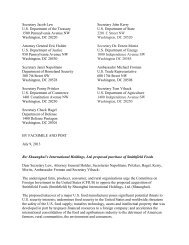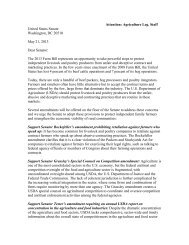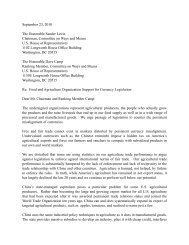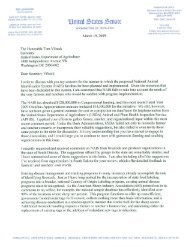Exhibit 8, 100416 Brazil FMD Risk Evaluation - R-Calf
Exhibit 8, 100416 Brazil FMD Risk Evaluation - R-Calf
Exhibit 8, 100416 Brazil FMD Risk Evaluation - R-Calf
Create successful ePaper yourself
Turn your PDF publications into a flip-book with our unique Google optimized e-Paper software.
ASF<br />
As with SVD, there is little information on the cost of control and eradication of ASF in a previously<br />
free region. In the absence of specific data on the cost of control and eradication, APHIS assumes a<br />
baseline cost similar to that of a small- to medium-sized CSF outbreak (see above).<br />
While these examples estimate a more severe outcome of an outbreak, the consequences could be<br />
lessened if the outbreak was detected earlier and appropriate controls implemented to quickly<br />
eradicate the disease.<br />
Environmental consequences<br />
Environmental consequences resulting from introduction of <strong>FMD</strong>, CSF, SVD, or ASF would<br />
primarily occur from disposal of carcasses due to death from disease or depopulation of herds, as<br />
well as disposal of contaminated bedding and manure. The methods of disposal employed in<br />
response to an outbreak would affect the environment differently. Disposal of contaminated<br />
materials could potentially affect air, water, and soil quality, as well as potentially releasing live<br />
virus into the environment.<br />
Disposal options previously employed in other countries in response to large-scale animal disease<br />
outbreaks include rendering, burial, and incineration. Factors influencing the decision as to which<br />
methods of disposal to use include the volume of contaminated material (dependent on the number<br />
of animals affected), geographic features (such as soil and surface water) of the areas where<br />
outbreaks occur, other environmental considerations such as weather and ambient temperature, and<br />
available emergency resources such as funds, equipment, and personnel. The environmental<br />
consequences of an outbreak of one of these diseases in the United States could vary from marginal<br />
to extreme depending on factors related to disposal of contaminated carcasses and materials.<br />
Public health consequences<br />
Although APHIS’ regulatory authority does not cover public health consequences, this assessment<br />
briefly addresses the issue. Direct public health consequences are insubstantial because the<br />
occurrence of <strong>FMD</strong>, CSF, SVD, or ASF virus in humans is quite rare. In fact, the number of cases<br />
reported is so small compared with the number of persons exposed to these viruses that the World<br />
Health Organization generally does not consider <strong>FMD</strong>, CSF, SVD, or ASF to be threats to humans.<br />
Perhaps more importantly, a substantial foreign animal disease outbreak can result in severe<br />
psychosocial effects on farmers and farming communities. Farmers and their families can suffer<br />
from grief over losing animals, in some cases bloodlines kept over many generations, as well as loss<br />
of control over their lives due to movement restrictions, disruptions in community life, and shortand<br />
long-term financial stress.<br />
Indirect consequences<br />
In addition to the direct costs of <strong>FMD</strong>, CSF, SVD, or ASF introduction, the effect on international<br />
trade and related domestic consequences must also be considered. Export losses caused by trade<br />
APHIS <strong>Evaluation</strong> of the Status of the <strong>Brazil</strong>ian State of Santa Catarina 68











